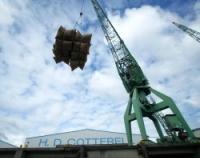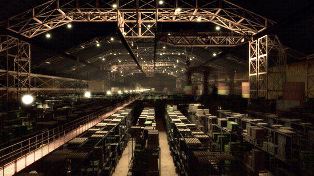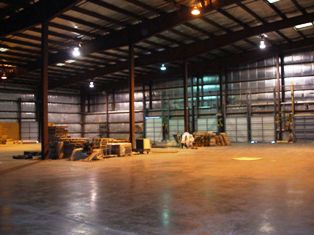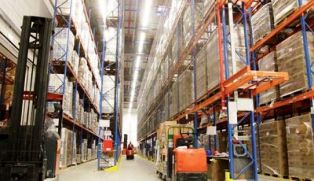Warehouse lighting
The lighting device of the warehouse areas is determined by their purpose, layout, dimensions and organization of unloading and loading and unloading activities on them.
In warehouses, where the work related to unloading, loading and storage is performed manually, the norms for artificial lighting prescribe the creation of lighting of 2 lux, in mechanized warehouses, the norm is illuminated 5 lux.
It should be noted that the increase in illumination in many cases is due to the lamps installed on the faucets. Therefore, the total lighting is calculated at 2 lux, and the installation of lamps (for example, deep emitters) and spotlights is provided on the faucets. Lighting in warehouse aisles should not be less than 0.5 lux.
 Below is the warehouse lighting of some of the most common materials, products and fuels.
Below is the warehouse lighting of some of the most common materials, products and fuels.
In coal warehouses, the dimensions of lignite and hard coal storage stacks do not exceed 2.5 m in height and 20 m in width. Conditions, but practically do not exceed 70 — 100 m wide and 10 — 15 m high.
In large mechanized warehouses for unloading and loading and unloading activities, various types of cranes and conveyors (belt, scraper, trough) are used, allowing continuous unloading and loading of coal and its distribution in piles.
To create uniform illumination, it is recommended to install the floodlight masts on both sides of the checkerboard arrangement line.
If the distance between the rows of masts does not exceed 50 — 60 m (when they are installed, for example, on the alleys, on both sides of the pile), then masts with a height of 10 — 15 m are chosen for illuminating piles up to 10 m high.
When lighting stacks with a height of 10 — 15 m, the height of the masts to be installed increases to 20 and even 30 m when the distance between the rows of masts is over 100 m.
Warehouse lighting
In power plants, floodlights may in some cases be placed on boiler room chimneys, usually located near the fuel stores.
Similar to the lighting of coal warehouses, communication is created between warehouses of different aggregates (sand, crushed stone, gravel).
Lighting manually stacked lumber yards is difficult. Wood material (boards, logs) are arranged in piles with a height of 2 — 3 m. The lighting of these piles can be carried out both with lamps and with spotlights.
It is much more difficult to solve the problems of mechanized warehouses, where the height of the stacks reaches 7 - 8 m. The wood is usually placed in groups of 8 - 12 piles, so that the area of each of them does not exceed 800 - 900 m2 . The distance between piles in a group is not less than 1.5 — 2 m.
Each group on the four sides adjacent to passages with a width of at least 8 — 12 m. Each 30 group of stacks form a quarter with an area of 4 hectares. Firebreaks of 25 — 30 m width are created between the districts. Mobile stackers are used to mechanize the stacking of timber. The transportation of sawn timber is carried out on carts or special wooden trucks and forklifts.
Luminaires can be used to illuminate such warehouses, but they must be installed at a height of at least 12 - 14 m, otherwise illumination will not be provided on the upper plane of the pile, where the main work of laying or dismantling of timber. The pillars are installed along the alleys along the perimeter of the pile groups, outside the dimensions of the alley.
Floodlights in such warehouses provide good illumination of the upper part of the high stacks, but the working surfaces of the low stacks, as well as the aisles between them, may be shaded by adjacent high stacks. Therefore, for such warehouses, the height of the searchlight masts should not be less than 20 m, and they should be placed in the corners of the stacking groups outside the dimensions of the aisles, at the intersection of the longitudinal and transverse aisles.
Floodlights must be installed with large angles of inclination (20 — 30 °). The rationality of using floodlights or lighting fixtures should be determined based on a variant calculation.
Lighting warehouses of metal and metal products is not difficult, since the height of the stacks in these warehouses does not exceed 3.5 m.For the most part, open warehouses are located in close proximity to production workshops, which is why floodlights are most often installed on the high parts of these buildings, as well as on crane structures, with all the means used in such warehouses.



